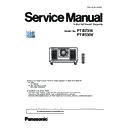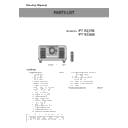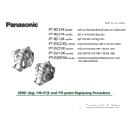Read Panasonic PT-RZ31K / PT-RS30K Service Manual online
Model No.
PT-RZ31K
PT-RS30K
3-chip DLP Based Projector
ORDER NO. VED1610634CE
Rev.-1 (2016-12)
■ This service manual is common to the models regardless of suffixes of the Model No.
• for India
• for India
PT-RZ31KD
• for other countries or regions
PT-RZ31K / PT-RS30K
■ Illustrations in this service manual
• Illustrations of the projector, screen, and other parts may vary from the actual product.
• Illustrations of the projector with the power cord attached are only examples.
The shape of the supplied power cords varies depending on the country where you purchased the product.
For replacement parts and exploded view, refer to the separated manual "PARTS LIST".
2
PREFACE
<RZ31K/RS30K>
The service technician is required to read and follow the “Safety Precautions” and “Important Safety Notice” in this service manual.
WARNING
This service information is designed for experienced repair technicians only and is not designed for use by the general public.
It does not contain warnings or cautions to advise non-technical individuals of potential dangers in attempting to service a product. Prod-
ucts powered by electricity should be serviced or repaired only by experienced professional technicians. Any attempt to service or repair
the product or products dealt with in this service information by anyone else could result in serious injury or death.
WARNING : Use laser Light Radiation eye and skin protection during servicing
AVERTISSEMENT : Utilisez laser lumière oeil radioprotection et la protection de la peau lors de l'entretien
CAUTION
Lithium
Lithium
Battery
Risk of explosion if battery is replaced by an incorrect type,
Replace only with the same of equivalent type recommended by the manufacturer.
Dispose of used batteries according to the manufacturer’s instructions.
About lead free solder (PbF)
This projector is using the P.C.Board which applies lead free solder.
Use lead free solder in servicing from the standpoint of antipollution for the global environment.
Notes:
• Lead free solder: Sn-Ag-Cu (tin, silver and copper) has a higher melting point (approx. 217°C) than standard solder Typically the melt-
ing point is 30~40 °C higher. When servicing, use a high temperature soldering iron with temperature limitation function and set it to
370 ± 10 °C.
• Be precautious about lead free solder. Sn-Ag-Cu (tin, silver and copper) will tend to splash when heated too high (approx. 600°C or
higher).
• Use lead free solder for the P.C.Board (specified on it as “PbF”) which uses lead free solder. (When you unavoidably use lead solder,
use lead solder after removing lead free solder. Or be sure to heat the lead free solder until it melts completely, before applying lead
solder.)
• After solder to double layered P.C Boards, check the component side for excess solder which may flow onto the opposite side.
About the identification of the lead free solder P.C.Board.
For the P.C.Board which applies lead free solder, the symbol as shown in the figure below is printed or stamped on the surface or the
back of P.C.Board.
PbF
Notice on laser
This projector is the Class 1 laser product that complies with IEC 60825-1.
This projector is the Class 1 laser product that complies with IEC 60825-1.
TQFX609
ョㄐㄓチワㄐㄓㄕㄉチモㄎㄆㄓㄊチ
éヤㄐㄎㄑㄍㄊㄆㄔチㄘㄊㄕㄉチビヒチヤョンチヱㄓㄕㄔチヒパフパハヒパチㄏㄅチヒパフパハヒヒ
ㄆㄙㄆㄑㄕチㄇㄐㄓチㄅㄆㄗㄊㄕㄊㄐㄏㄔチㄑㄖㄓㄔㄖㄏㄕチㄕㄐチロㄔㄆㄓチワㄐㄕㄊㄆ
ワㄐハブパチㄅㄕㄆㄅチㄋㄖㄏㄆチビフハビパパヘê
リユヤチプパベビブノヒホビパパヘ
ロモヴユンチンモュリモヵリヰワ
モヷヰリュチュリンユヤヵチユヺユチユヹヱヰヴヶンユ
ヤロモヴヴチピンチロモヴユンチヱンヰュヶヤヵ
ヸモヷユチロユワヨヵラホフフベノフプビㄏㄎ
ヮモヹリヮヶヮチヰヶヵヱヶヵホピピピㄎヸ
リユヤチプパベビブノヒホビパパヘ
ンモヺヰワワユヮユワヵチロモヴユン
ユヹヱヰヴリヵリヰワチュリンユヤヵユチュモワヨユンユヶヴユチヱヰヶンチロユヴチヺユヶヹ
モヱヱモンユリロチチロモヴユンチュユチヤロモヴヴユチピン
ロヰワヨヶユヶンヴチュトヰワュユヴホフフベノフプビㄏㄎ
ヮモヹリヮモロユチュヶチンモヺヰワワユヮユワヵホピピピㄎヸ
For North America
Warning
: This projector would become Class IIIb laser product if used with interchangeable lens, types ET-D75LE8/LE30/LE40;
and if used without lens hood mounted over the long lens. If you use under this condition, you must receive variance approval
letter from FDA before usage. For details on how to mount the lens hood, refer to the Operating Instructions.
Pour l’Am
letter from FDA before usage. For details on how to mount the lens hood, refer to the Operating Instructions.
Pour l’Am
érique du Nord
Avertissement
: Ce projecteur devient un produit laser de Classe IIIb s’il est utilis
é avec des objectifs interchangeables, de
types ET-D75LE8/LE30/LE40; et s’il est utilis
é sans le pare-soleil installé sur l’objectif long. Pour l’utiliser dans ces conditions, vous
devez obtenir une lettre d’approbation de variation de la FDA avant l’utilisation. Pour des d
étails sur la manière d’installer
le pare-soleil, reportez-vous au manuel d’utilisation.
DPQT1099ZA
The class 4 laser module is mounted in the inside of a product.
TQFX608
ュモワヨユンノヤロモヴヴチフチロモヴユンチンモュリモヵリヰワチヸラユワチヰヱユワチモヷヰリュチユヺユチヰン
チチチチチチチチチチチチチチチチチチチヴレリワチユヹヱヰヴヶンユチヵヰチュリンユヤヵチヰンチヴヤモヵヵユンユュチンモュリモヵリヰワ
ュモワヨユンノンモヺヰワワユヮユワヵチロモヴユンチュユチヤロモヴヴユチフチノチユワチヤモヴチュトヰヶヷユンヵヶンユチ
ュモワヨユンノンモヺヰワワユヮユワヵチロモヴユンチュユチヤロモヴヴユチフチノチユワチヤモヴチュトヰヶヷユンヵヶンユチ
チチチチチチチチチチチチチチチチチチユヹヱヰヴリヵリヰワチュモワヨユンユヶヴユチモヶチンモヺヰワワユヮユワヵチュリンユヤヵチヰヶチ
チチチチチチチチチチチチチチチチチチュリョョヶヴチュユヴチヺユヶヹチヰヶチュユチロモチヱユモヶ
3
PREFACE
<RZ31K/RS30K>
There are special components used in this equipment which are important for safety. These parts are marked by 7 in the schematic dia-
gram, circuit board diagrams, exploded views and replacement parts list. It is essential that these critical parts should be replaced with
manufacturer’s specified parts to prevent shock, fire, or other hazards. Do not modify the original design without permission of manufacturer.
IMPORTANT SAFETY NOTICE
Caution:
This equipment has been tested and found to comply with the limits for a Class A digital device, pursuant to part 15 of the FCC Rules. These
limits are designed to provide reasonable protection against harmful interference when the equipment is operated in a commercial environ-
ment. This equipment generates, uses, and can radiate radio frequency energy and, if not installed and used in accordance with the instruc-
tion manual, may cause harmful interference to radio communications. Operation of this equipment in a residential area is likely to cause
harmful interference in which case the user will be required to correct the interference at his own expense.
FCC Warning:
To assure continued compliance, follow the attached installation instructions. This includes using the provided power cord and shielded inter-
face cables when connecting to computer or peripheral devices. Also, any unauthorized changes or modifications to this equipment could void
the user’s authority to operate this device.
Chapter 1
Preparation — Precautions for use
ENGLISH - 17
Precautions for use
Cautions when transporting
f Transport the projector with four or more people. Failure to do so may drop the projector, which may result in
damage or deformation of the projector, or injury.
f
When transporting the projector, hold it securely by its front side and back side handles and avoid excessive
vibration and impacts. Failure to do so may cause a failure due to the damaged internal components.
vibration and impacts. Failure to do so may cause a failure due to the damaged internal components.
f
Do not transport the projector with the adjustable feet extended. Doing so may damage the adjustable feet.
Cautions when installing
rDo not set up the projector outdoors.
The projector is designed for indoor use only.
rDo not set up the projector in the following locations.
f
Places where vibration and impacts occur such as in a car or vehicle: Doing so may cause damage to internal
components or malfunction.
components or malfunction.
f
Location close to sea or where corrosive gas may occur: The projector may fall due to corrosion. Also, failure to
do so may shorten the life of the components and result in malfunctions.
do so may shorten the life of the components and result in malfunctions.
f
Near the exhaust of an air conditioner: Depending on the conditions of use, the screen may fluctuate in rare
cases due to the heated air from the air exhaust port or the hot or cooled air. Make sure that the exhaust
from the projector or other equipment, or the air from the air conditioner does not blow toward the front of the
projector.
projector.
f
Places with sharp temperature fluctuations such as near lights (studio lamps): Doing so may shorten the life of
the light source, or result in deformation of the projector due to heat, which may cause malfunctions.
Follow the operating environment temperature of the projector.
the light source, or result in deformation of the projector due to heat, which may cause malfunctions.
Follow the operating environment temperature of the projector.
f
Near high-voltage power lines or near motors: Doing so may interfere with the operation of the projector.
f
Places where there is high-power laser equipment: Directing a laser beam onto the projection lens surface
causes damage to the DLP chips.
r
Ask a qualified technician or your dealer to do installation work such as mounting the
projector on the ceiling, including installation work that uses eyebolts.
projector on the ceiling, including installation work that uses eyebolts.
To ensure projector performance and security, ask a qualified technician or your dealer when installing the
projector in a method other than the floor installation or when installing the projector in a high place.
r
Ask a qualified technician or your dealer to install the cable wiring for DIGITAL LINK
connection.
connection.
Image and sound may be disrupted if cable transmission characteristics cannot be obtained due to inadequate
installation.
installation.
rThe projector may not work properly due to strong radio wave from the broadcast
station or the radio.
If there is any facility or equipment which outputs strong radio waves near the installation location, install the
projector at a location sufficiently far from the source of the radio waves. Or, wrap the LAN cable connected to the
<DIGITAL LINK/LAN> terminal using a piece of metal foil or a metal pipe which is grounded at both ends.
rFocus adjustment
The high clarity projection lens is thermally affected by the light from the light source, making the focus unstable in
the period just after switching on the power. It is recommended that images be projected continuously for at least
30 minutes before the focus is adjusted.
the period just after switching on the power. It is recommended that images be projected continuously for at least
30 minutes before the focus is adjusted.
rDo not install the projector at an altitude of 4 200 m (13 780') or higher above sea level.
4
PREFACE
<RZ31K/RS30K>
Chapter 1
Preparation — Precautions for use
18 - ENGLISH
rDo not use the projector in a location that the ambient temperature exceeds 50 °C
(122 °F).
Using the projector in a location that the altitude is too high or the ambient temperature is too high may reduce the
life of the components or result in malfunctions.
The upper limit of the operating environment temperature differs depending on the altitude or the setting of the
[PROJECTOR SETUP] menu → [OPERATION SETTING] → [OPERATING MODE].
life of the components or result in malfunctions.
The upper limit of the operating environment temperature differs depending on the altitude or the setting of the
[PROJECTOR SETUP] menu → [OPERATION SETTING] → [OPERATING MODE].
Altitude above sea level
Setting for [OPERATING MODE]
[HIGH], [NORMAL], [USER1], [USER2],
[USER3]
[USER3]
[LONG LIFE1], [LONG LIFE2], [LONG LIFE3]
Altitude of 0 m (0') or higher
to lower than 1 400 m
(4 593')
to lower than 1 400 m
(4 593')
0 °C (32 °F) to 50 °C (122 °F)
0 °C (32 °F) to 45 °C (113 °F)
Altitude of 1 400 m (4 593')
or higher to lower than
2 700 m (8 858')
or higher to lower than
2 700 m (8 858')
0 °C (32 °F) to 45 °C (113 °F)
Altitude of 2 700 m (8 858')
or higher to lower than
4 200 m (13 780')
or higher to lower than
4 200 m (13 780')
The projector cannot be used.
When the Smoke Cut Filter is used, the operating environment temperature should be between 0 °C (32 °F) and
40 °C (104 °F) regardless of the [OPERATING MODE] setting. It cannot be used at an altitude of 1 400 m (4 593')
or higher above sea level.
or higher above sea level.
rProjection in all 360° direction is possible.
360°
360°
360°
360° vertically
360° horizontally
360° tilted
(combination of vertical and horizontal)
Cautions when setting up the projector
f
Install the projector in a place or with a mount that can sufficiently tolerate the weight. The position of the
projected image may shift if the strength is not sufficient.
f
Use the adjustable feet only for the floor standing installation and for adjusting the angle. Using them for other
purposes may damage the projector.
purposes may damage the projector.
f
The adjustable feet can be removed if not needed in the installation. However, do not use the screw holes
where the adjustable feet were removed to fix the projector to a mount.
Also, do not insert any screws other than the eyebolts for the installation work into the screw holes of the
Also, do not insert any screws other than the eyebolts for the installation work into the screw holes of the
adjustable feet. Do not insert the removed adjustable feet into other M10 screw holes.
f
Do not fix the projector to a mount with the screw holes for eyebolts (4 locations on each side) on the top side,
right and left sides, and back side.
right and left sides, and back side.
f
When installing and using the projector in a method other than the floor installation using the adjustable feet,
remove the adjustable feet (4 locations) and use the six screw holes to fix the projector to a mount (as shown in
the figure).
Chapter 1
Preparation — Precautions for use
ENGLISH - 17
Precautions for use
Cautions when transporting
f Transport the projector with four or more people. Failure to do so may drop the projector, which may result in
damage or deformation of the projector, or injury.
f
When transporting the projector, hold it securely by its front side and back side handles and avoid excessive
vibration and impacts. Failure to do so may cause a failure due to the damaged internal components.
vibration and impacts. Failure to do so may cause a failure due to the damaged internal components.
f
Do not transport the projector with the adjustable feet extended. Doing so may damage the adjustable feet.
Cautions when installing
rDo not set up the projector outdoors.
The projector is designed for indoor use only.
rDo not set up the projector in the following locations.
f
Places where vibration and impacts occur such as in a car or vehicle: Doing so may cause damage to internal
components or malfunction.
components or malfunction.
f
Location close to sea or where corrosive gas may occur: The projector may fall due to corrosion. Also, failure to
do so may shorten the life of the components and result in malfunctions.
do so may shorten the life of the components and result in malfunctions.
f
Near the exhaust of an air conditioner: Depending on the conditions of use, the screen may fluctuate in rare
cases due to the heated air from the air exhaust port or the hot or cooled air. Make sure that the exhaust
from the projector or other equipment, or the air from the air conditioner does not blow toward the front of the
projector.
projector.
f
Places with sharp temperature fluctuations such as near lights (studio lamps): Doing so may shorten the life of
the light source, or result in deformation of the projector due to heat, which may cause malfunctions.
Follow the operating environment temperature of the projector.
the light source, or result in deformation of the projector due to heat, which may cause malfunctions.
Follow the operating environment temperature of the projector.
f
Near high-voltage power lines or near motors: Doing so may interfere with the operation of the projector.
f
Places where there is high-power laser equipment: Directing a laser beam onto the projection lens surface
causes damage to the DLP chips.
r
Ask a qualified technician or your dealer to do installation work such as mounting the
projector on the ceiling, including installation work that uses eyebolts.
projector on the ceiling, including installation work that uses eyebolts.
To ensure projector performance and security, ask a qualified technician or your dealer when installing the
projector in a method other than the floor installation or when installing the projector in a high place.
r
Ask a qualified technician or your dealer to install the cable wiring for DIGITAL LINK
connection.
connection.
Image and sound may be disrupted if cable transmission characteristics cannot be obtained due to inadequate
installation.
installation.
rThe projector may not work properly due to strong radio wave from the broadcast
station or the radio.
If there is any facility or equipment which outputs strong radio waves near the installation location, install the
projector at a location sufficiently far from the source of the radio waves. Or, wrap the LAN cable connected to the
<DIGITAL LINK/LAN> terminal using a piece of metal foil or a metal pipe which is grounded at both ends.
rFocus adjustment
The high clarity projection lens is thermally affected by the light from the light source, making the focus unstable in
the period just after switching on the power. It is recommended that images be projected continuously for at least
30 minutes before the focus is adjusted.
the period just after switching on the power. It is recommended that images be projected continuously for at least
30 minutes before the focus is adjusted.
rDo not install the projector at an altitude of 4 200 m (13 780') or higher above sea level.





